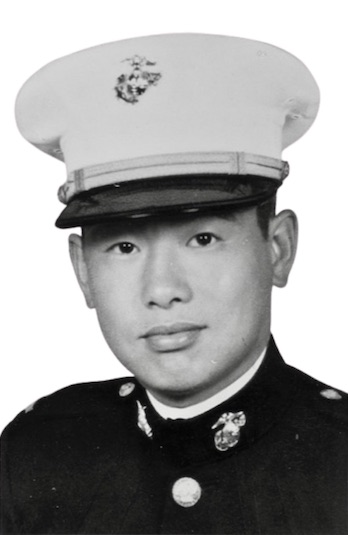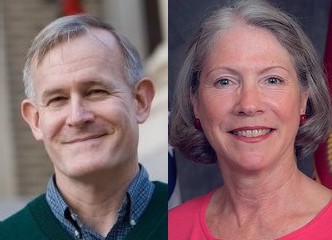Fellow Marine Pat Garrett uncovers a remarkable backstory.
By P.C. Staff
When 2nd Lt. Kay Kazu Kimura, USMC, was killed in action on March 7, 1970, at age 26, he had been stationed in Vietnam for only about three months.

2nd Lt. Kay Kazu Kimura, USMC, who was killed March 7, 1970, at age 26
According to retired Col. Pat Garrett, USMC, Kimura had nevertheless in that short time “established himself as a star early on — he was focused and good at everything at what he did. My sense is that he had established himself in the mind of the squadron as one of the ‘good ones.’”
Garrett told the Pacific Citizen he began researching Kimura’s story after his wife, retired Maj. Gen. Tracy Garrett, USMC, had identified Kimura as someone possibly worthy of creating a namesake scholarship for the Marine Corps Scholarship Foundation as a means to address a situation with the Marine Corps vis-à-vis Japanese Americans.
“One of the problems that the Marine Corps has had, candidly, is that . . . unlike the Army, the Marine Corps has not had a great representation in the Japanese American community,” Pat said.
When Tracy came across Kay’s Japanese surname, Pat said she “was kind of intrigued by that because that’s fairly uncommon.” He volunteered to conduct some internet research on Kimura.
One of the facts he learned, as mentioned, was that Kimura had only been in Vietnam for about three months. The other was that Kimura, who was born in 1943 at the Poston War Relocation Center in Arizona, had posthumously been awarded the Distinguished Flying Cross.
“It was extraordinary to get the DFC, you know, for a kid that hadn’t even qualified as a pilot in command to get the Distinguished Flying Cross,” said Garrett.
Garrett learned that Kimura’s DFC was awarded for his actions that took place before the mission that killed him, gunner Sgt. Andrew William Smith, pilot Capt. Albert Henry Gates Jr. and crew chief Cpl. Glenn Frederic Austin. Door gunner Ed Bohan was the mission’s lone survivor.
Four days before that fatal mission, Kimura was involved in a hair-raising mission that earned him the DFC.
“The helicopter squadron that he was assigned to had a mission that was heavily focused on supporting reconnaissance operations in the mountainous areas, inland from the Hue–Da Nang region of Vietnam,” Garrett said. The squadron conducted many extractions of recon teams that had been inserted into hostile territory.
According to Garrett, Kimura had been the co-pilot in a chopper that had gone in to extract a reconnaissance team and “came under extremely heavy enemy fire in the zone.”
“Kay essentially took over,” Garrett said, “coordinating things for the whole mission while his pilot concentrated on trying to keep the aircraft in the sky that involves not just a whole bunch of piloting skills, but a whole bunch of talking on the radio, coordinating with supporting arms, fire support and things.
“For a brand-new guy, on one of his first combat missions,” he continued, “it was just extraordinary that he did so well.”
The irony was that the mission for which Kimura and his crewmates lost their lives was one that might be considered comparatively low-risk: flying escort for a three-star general — and one for which Kimura was a last-minute replacement.
There were, however, a couple of ominous factors. One was the weather, which had turned “zero-zero,” meaning the visibility needed for horizontal and vertical reference was nearly nil. “The weather was so bad that even extract missions hadn’t been launching,” Garrett said.
Nevertheless, the CH-46 Sea Knight helicopter carrying the five men took off.

Ret. Col. Pat Garrett, USMC, left, and Ret. Maj. Gen. Tracy Garrett
“They somehow managed to meet up with the other helicopter,” said Garrett. Then, a squall came in, and the already bad visibility worsened. Then, the other ominous occurrence took place. According to the lone survivor, a moment or two later, “there was a very loud bang from the back of the helicopter.”
“He recalled seeing Kay and the pilot look back toward the tail to see what was going on, and a moment later, the aircraft crashed into the water,” Garrett said. The source of the loud noise remains a mystery.
Kimura’s body was recovered about a week later. “People were genuinely affected by someone like him being killed,” Garrett said, including Barbara Berthiaume, also of Port Townsend, but formerly of Nampa, Idaho.
Although a couple years younger than Kay Kimura, Berthiaume, née Yoshida, remembers him as the older brother that Ted Kimura, a classmate who was her age, looked up to. Berthiaume says Kay Kimura’s death was “a huge blow” to the whole family and Kay’s widow, Naomi (Nagai) Kimura, who is now, like Ted Kimura, deceased.
The Marine Corps Scholarship Fund has created a scholarship in honor of Kimura, but according to Tracy Garrett, the Kay Kimura scholarship is not yet an endowed, perpetual scholarship. She said that to make that happen would entail raising about $100,000.
Berthiaume, meantime, is hopeful that an endowed, perpetual scholarship for Kay Kazu Kimura does eventually come to fruition as more people learn the story of this remarkable young man’s brief but promising life, cut short in service to his country.



